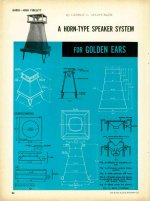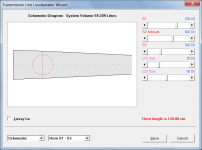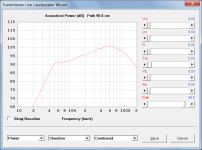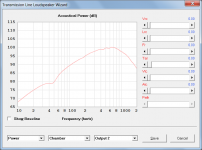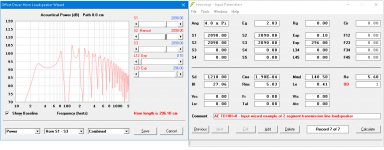Huh......one of my all time favorite demos was a Khorn with a crites xo
And heck if camplo is crossing that cd at 300 then I don’t see why not!
Yes, one of the many 'keys' to creating a 'live' illusion is a < 500 Hz XO point where our hearing acuity is rolling off except at very high SPLs and better below an average female's ~300 Hz lowest note and short of no XO point, at the ~100 Hz of an average man's lowest note out to ~ 8 kHz to cover all human voice output, though based on how the pioneers dealt with it, from ~100-300 Hz it can drop ~10 dB presumably due to not having to 'compete' with the female's voice, i.e. apparently more about keeping an XO out of our vocals BW, so with all digital systems it may be moot.
GM
It's easy to see why floor-to-ceiling line arrays, like wesayso's towers, excel in this regard.
Idk.....mine cross at 1.8k, (2nd order lp/1st order hp)subs take over @60hz.
They are 2 way (mid is not hooked up) my xo’s are worth more the speakers (Dayton pa255 with 1” airspring inverted tweeter.) I really think it has more to do with keeping in ‘the zone’
If I can get that effect back in a different room with different speakers that would certainly be on track to learning more about it. What would you call this effect being discussed anyway? Feel kinda stupid not knowing what to call ‘it’ although this is the only handful of people that even know what ‘it’ is!
They are 2 way (mid is not hooked up) my xo’s are worth more the speakers (Dayton pa255 with 1” airspring inverted tweeter.) I really think it has more to do with keeping in ‘the zone’
If I can get that effect back in a different room with different speakers that would certainly be on track to learning more about it. What would you call this effect being discussed anyway? Feel kinda stupid not knowing what to call ‘it’ although this is the only handful of people that even know what ‘it’ is!
Probably something along the lines of creating single point like results with multiple drivers. "It" is near perfect delay and phase alignment. Call it very low distortion of the time domain. You can argue that it is achievable regardless the placement of the xover but the point is if there is no xover in "that" bandwidth, there is no battle to be won there as well. A wise man once said, chose your battles wisely. If I feel forced to use a tweeter, 10khz is a good place for a xover.
I played with hornresp for the last hour or so, I can't make it do what I think it should, the numbers looked right, my driver fs was lower than I wanted it to say, as reported by AE, but more importantly when I ran acoustical power it was a very rippled line....I tried creating a straight transmission line that was 1/4th of 29hz. I can tell something is wrong because when I run sim, signal is only emitting into the tl instead of coming out of both sides, which is probably where the rest of my output is....I can't get it to chose a driver diameter size...I wonder if there is more straight forward software somewhere.
I played with hornresp for the last hour or so, I can't make it do what I think it should, the numbers looked right, my driver fs was lower than I wanted it to say, as reported by AE, but more importantly when I ran acoustical power it was a very rippled line....I tried creating a straight transmission line that was 1/4th of 29hz. I can tell something is wrong because when I run sim, signal is only emitting into the tl instead of coming out of both sides, which is probably where the rest of my output is....I can't get it to chose a driver diameter size...I wonder if there is more straight forward software somewhere.
Ok......Optimum Driver Phase Time Alignment
ODPTA unless someone can think of something better!
What f3/f10 do you get with just a proper ported box module?
ODPTA unless someone can think of something better!
What f3/f10 do you get with just a proper ported box module?
It's easy to see why floor-to-ceiling line arrays, like wesayso's towers, excel in this regard.
Especially since another 'key' is 'there's no replacement for displacement', which can be a bunch when an 'inifinite' array [both ceiling and floor coupled].
GM
I played with hornresp for the last hour or so, I can't make it do what I think it should, the numbers looked right, my driver fs was lower than I wanted it to say, as reported by AE, but more importantly when I ran acoustical power it was a very rippled line....I tried creating a straight transmission line that was 1/4th of 29hz. I can tell something is wrong because when I run sim, signal is only emitting into the tl instead of coming out of both sides, which is probably where the rest of my output is....I can't get it to chose a driver diameter size...I wonder if there is more straight forward software somewhere.
??? 'Sounds' like you might be trying to design a single driver horn from the Input Wizard, not the Wizard I was referring to.
You have to either load the driver you want or you can highlight a specific spec and type a new one in and it recalculates everything. Double clicking on the [Sd] field pops up a T/S specs input window.
Or just [Save] it and export it to here, so we can load/review/correct it.
If there's easier and accurate for what all it does, I'm not aware of it. Of course using the HELP File is normally required as it's now got way more features/options than it was designed for, so not very intuitive initially [or ever in my case 🙁].
GM
You can use either Leonard Audios Transmission line (find download here on diyaudio or honresp to model the lines. The Mathcad sheets are no longer supported by Martin.Martin J. King mathcad - Anyone gotta copy to share?
I think I have an installer of LA TL stashed somewhere.
Just be aware that a 15-18" tline tuned low will be huge...
Johan-Kr
DIY project by George L. Augspurger, published in Radio Electronics Magazine, April 1956.
Wow this is where the Aquarius series had its birth from!?
AQUARIUS
Rob🙂
Martin J. King mathcad - Anyone gotta copy to share?
All you need is to get familiar with HR as I doubt MJK's later WSs with some basic room options will be of much use to you since your sub
Note too that there's no auto anything, so with no experience all one can do is keep changing dims till you think it's good enough whereas you can change whole areas at a time in real time with HR's Wizard and why I quit using MJK's long ago.
That said, it just dawned on me that you can use his very accurate Classic TL Alignment Tables/Excel WS or design your own table calculator to match up to HR's inputs from the Word doc to input into HR: Transmission Line Theory
Actually, I'm kind of surprised no one's done it [yet] AFAIK [hint, hint 😉].
GM
Just be aware that a 15-18" tline tuned low will be huge...
Johan-Kr
Indeed, a basic bass TL with such a high Vas, low Qts can be from near Vas size to > 4x Vas depending on how much LF gain BW you need.
GM
That seems to be the case, well spotted.
George Augspurger was (also) involved in designing the Aquarius range and it looks like he took inspiration from his earlier DIY project.
However, the collumns of the Aquarius speakers weren't true horns, but (stuffed) dual chamber reflex cabs.
I need to experiment with HR, I used the wizard to create a transmission line and one side is always closed.
If you have a box that’s 25x30x30, you could create a folded Tm with 3 thick folded channels, and shorter tuning, or thin channels with lots of folds and deeper tuning...now the latter is not text but what happens? Tuning is determined by length of the path....with many folded thin channels you get the length but what’s the loss?
If you have a box that’s 25x30x30, you could create a folded Tm with 3 thick folded channels, and shorter tuning, or thin channels with lots of folds and deeper tuning...now the latter is not text but what happens? Tuning is determined by length of the path....with many folded thin channels you get the length but what’s the loss?
Hmm, do you mean one end of the TL is closed? It should be. Otherwise still no clue what the problem is.
The box has 'X' volume available, so the one with the least number of folds will have the most available net volume [Vb], hence will have the most bass gain at a higher Qt/lower F3, F10, Fp, ergo the smaller, longer one will have a lower Qt/lower F3, F10, Fp.
The more folds the greater its friction, bend losses, so will need to be increasingly longer with increasing folds to match an HR sim. Total line area [S1] etc., increases with increasing folds to maintain the same acoustic path length = bigger box and one reason why you see few folds in bass horns.
Note that for the TD18H your acoustically 'small' box size will be a low gain, low Qt one no matter how you fold it.
GM
The box has 'X' volume available, so the one with the least number of folds will have the most available net volume [Vb], hence will have the most bass gain at a higher Qt/lower F3, F10, Fp, ergo the smaller, longer one will have a lower Qt/lower F3, F10, Fp.
The more folds the greater its friction, bend losses, so will need to be increasingly longer with increasing folds to match an HR sim. Total line area [S1] etc., increases with increasing folds to maintain the same acoustic path length = bigger box and one reason why you see few folds in bass horns.
Note that for the TD18H your acoustically 'small' box size will be a low gain, low Qt one no matter how you fold it.
GM
I used the wizard to create a transmission line and one side is always closed.
Attachment 1 shows the schematic diagram for a simple transmission line loudspeaker designed using the Input Wizard. The dotted red circle shows the offset driver. The rear side of the diaphragm faces into the transmission line, and the front side radiates directly.
Attachment 2 shows the combined power response. Attachment 3 shows the output from the transmission line only (Output 1) and Attachment 4 shows the output from the front direct radiating side of the driver only (Output 2).
Attachments
Some commercial nostalgia still exist, good price considering the manual work of the cell...
http://www.lautsprecher-berlin-shop...bjectPath=/Shops/62721881/Products/ie-mzb1000
Klughoerner.de >> Markus Klug und seine Horner
http://www.lautsprecher-berlin-shop...bjectPath=/Shops/62721881/Products/ie-mzb1000
Klughoerner.de >> Markus Klug und seine Horner
Attachment 1 shows the schematic diagram for a simple transmission line loudspeaker designed using the Input Wizard. The dotted red circle shows the offset driver. The rear side of the diaphragm faces into the transmission line, and the front side radiates directly.
Attachment 2 shows the combined power response. Attachment 3 shows the output from the transmission line only (Output 1) and Attachment 4 shows the output from the front direct radiating side of the driver only (Output 2).
If you run a wavefront sim of that I bet the left side is closed...the waves bounce off of the wall and return to the driver. How can it show you a true combined response without the output of the front of the driver actually leaving the cabinet? Depending on how close to that wall i bet the response changes. I'm probably not understanding something but, thats what I see.
Attachments
Last edited:
Here’s a setup that seems to meet the original criteria using the td18h+Dual AE TD18H+ Mains -TD15M center by Lukeamdman
Camplo, if you go to the build pics the speakers are modular.......might be something to look at?
Camplo, if you go to the build pics the speakers are modular.......might be something to look at?
Last edited:
- Home
- Loudspeakers
- Multi-Way
- Is it possible to cover the whole spectrum, high SPL, low distortion with a 2-way?
